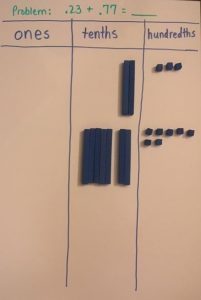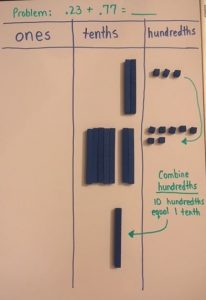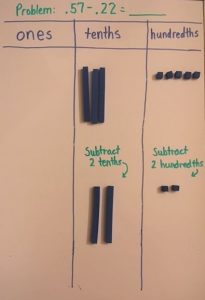by C. Elkins, OK Math and Reading Lady
Last week, we looked at some ways to gain number sense about decimals. This post will address using decimals in the operations of addition and subtraction . . . and how to model concretely and pictorially. You can also download the color grid pages along with a free decimal math game in this post. Part 3 (future post) will address multiplication and division of decimals.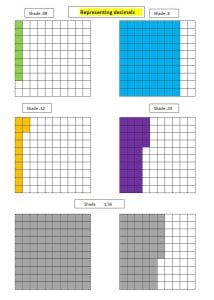
If you missed last week’s post, please review it first before continuing with this one. Before performing various operations with decimals, students must have a basic understanding of how to represent them concretely, pictorially and numerically. Example: .8 = .80 can be proven with base ten blocks and with 100 grid drawings. This understanding should also be linked to fractions: 8/10 is equivalent to 80/100. Click here for pdf of Representing Decimals page.
Addition
For concrete practice, use a 100 base ten block to represent the whole (ones), the tens rod to represent tenths, and unit blocks to represent hundredths. Construct each addend and then combine them. Ten tenths’ rods become one whole. Ten hundredths cubes become one tenth.
- Show both addends
- Regroup 100ths into 10ths
- Regroup tenths into ones
- Trade 10 tenths for 1 whole
 In a pictorial model, shade in the ones, tenths and hundreds on hundred grids. Use different colors to represent each addend. Click here for pdf of Adding Decimals page.
In a pictorial model, shade in the ones, tenths and hundreds on hundred grids. Use different colors to represent each addend. Click here for pdf of Adding Decimals page.
The concrete and pictorial models will also prove .8 = .80, reinforcing the concept that adding a zero to the right of a decimal does not change its value. This will be an important factor when moving to the standard algorithm vertical addition model.
Using an open number line is also a good pictorial model to use when adding decimals, especially if students are already familiar with its use regarding addition of whole numbers. This method reinforces number sense of the base ten system because you continually think, “What goes with .07 to make a tenth?” (answer = .03); or “What goes with .9 to make a whole?” (answer: .1).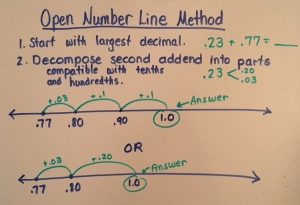
A method called partial sums should also help students gain place value number sense along with addition of decimals. Each step is broken down (decomposed). 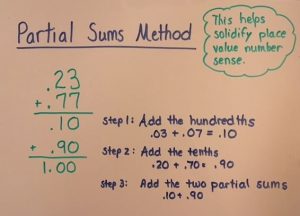
Estimating will also be a critical addition problem solving step focusing on number sense. If adding 34.78 plus 24.12, does the student realize their answer should be somewhere close to 35 + 24? Are they thinking, “Is my first number closer to 34 or 35?” What is halfway between 34 and 35 (34.5 or 34.50)? Where would 34.78 fall if it was on a numberline between 34 and 35? (See my post on rounding for more details.)
Using the standard algorithm, students will be able to condense the steps and compare to previous methods. Utilize the concept of adding a zero to the right of the decimal to help a student line everything up vertically. Turn notebook paper sideways so the vertical lines help with alignment. Compare to addition using the same digits without decimals (digits in the answer should be the same whether adding 3,478 + 2,412 vs. 34.78 + 24.12).
Click on the link for a free fun game to reinforce addition of decimals. It is called Race to 1: A Decimal Addition Game.
Subtraction
For concrete practice, construct a model to show the decimal with the higher value first. Then remove the blocks to be subtracted. Some trading may be needed along the way. Count what’s left for the answer.
- Show .57
- To subtract, move down .22
- Answer = remaining amount
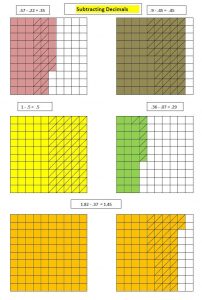
Using a pictorial model, shade the decimal with the higher value. Then cross off the amount to be subtracted. Click here for pdf of Subtracting Decimals page.
With an open number line, the problem can be shown by counting back . . . but I prefer counting up from the lower number to the higher number to find the difference. As with addition, or with whole numbers, thorough knowledge of combinations of 10 are very helpful.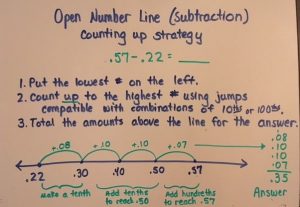
Compensation is a method many fourth and fifth graders should begin to understand. It emphasizes number sense over performing steps. Compensation means adjusting numbers to make them easier to work with. If the problem was 3 – 2.56. Do they know it can be solved as 300-256 (or even 299-255)? Do they know it can be solved as 2.99 – 2.55? How??? 2.99 is .01 away from 3 in the same way that 2.55 is .01 away from 2.56. As long as the difference is still the same, you will get the same result. When adjusting or compensating this eliminates the need for regrouping. 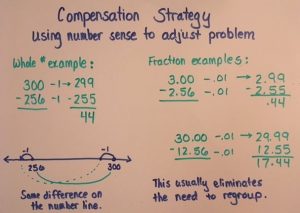
Standard Algorithm: Using the standard algorithm, students will be able to condense the steps and compare to previous methods. Utilize the concept of adding a zero to the right of the decimal to help a student line everything up vertically. Turn notebook paper sideways so the vertical lines help with alignment. Compare to subtraction using the same digits without decimals (digits in the answer should be the same whether subtracting 3,478 – 2,412 vs. 34.78 – 24.12).
Enjoy your decimal discoveries!! Have a good example you want to share? Let us know.
Have a great week! Cindy Elkins aka OK Math and Reading Lady
